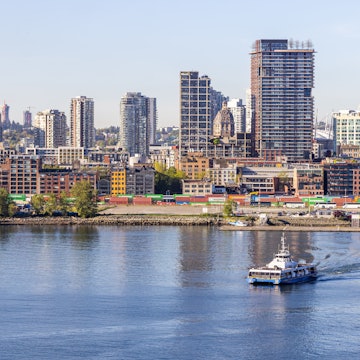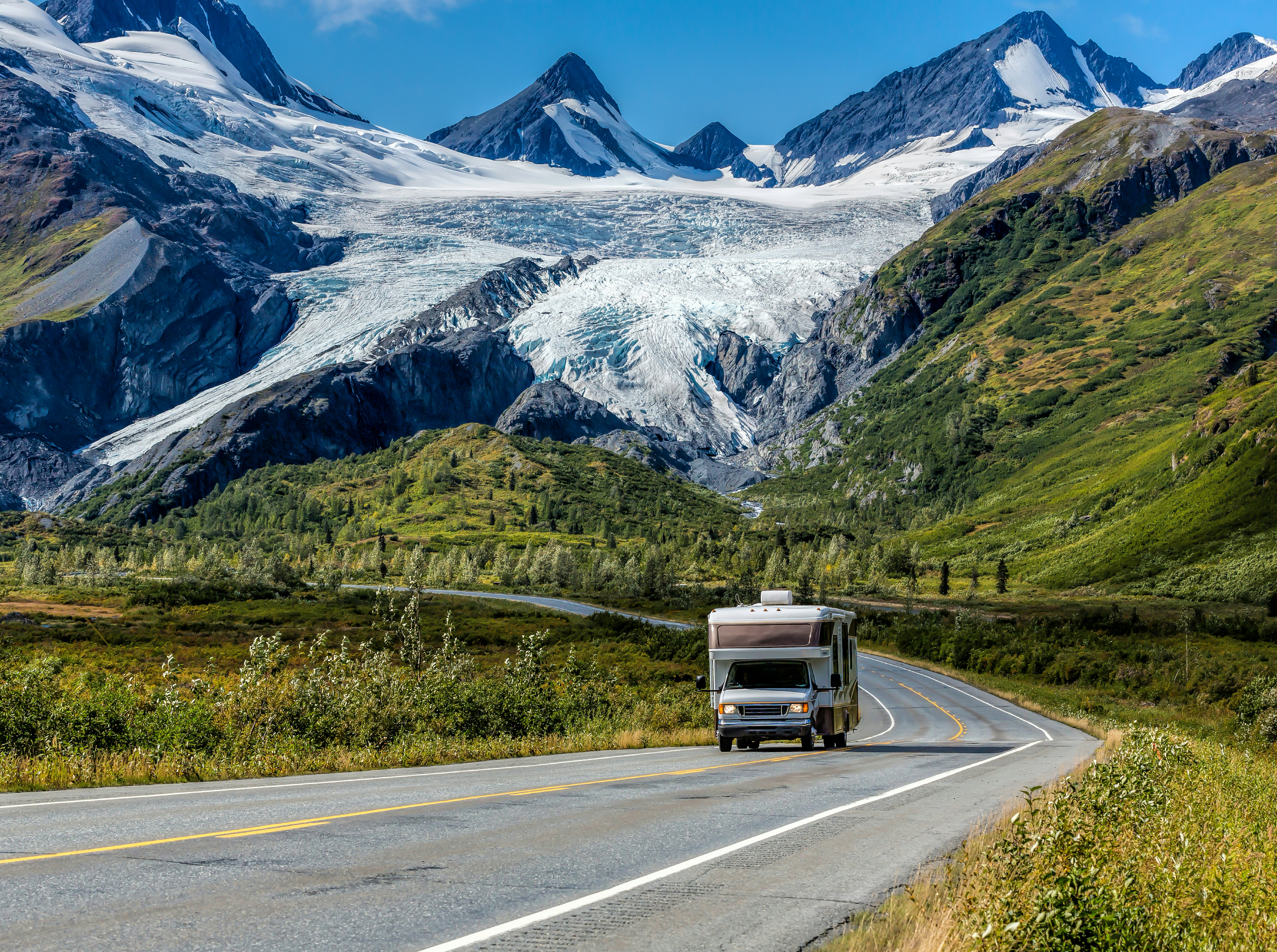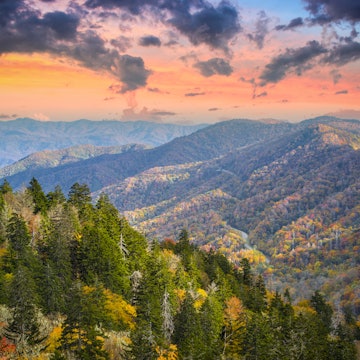

It's easier to see Alaska with your own vehicle but there are public transport options too © attilio pregnolato / Shutterstock
Getting around Alaska can be challenging. Alaska is the largest state in the USA, so it takes time to travel between points, especially if you plan to visit coastal cities as well as the interior. The best way to see Alaska is through a combination of transport options on land and sea.
With enough time and planning, it is also possible to get off the beaten path and experience real adventure in North America’s “Last Frontier.” Two weeks is recommended to see all of the major sites.
Navigating around Alaska by private vehicle provides independence. A cruise ship gives amenities and ease of travel, and the train provides a scenic route to your destination.
Regardless of how you choose to travel, remember that the most consistent thing about Alaska weather is its inconsistency. Be prepared with layers of non-cotton clothing that can be easily removed or added. Always have a good rain jacket and sturdy shoes suitable for walking on uneven terrain. While some Alaskans can and do wear sneakers or sandals, it is advisable to have shoes with tread. It’s customary to remove shoes when entering someone’s home.
Read on for how to navigate this vast US state.
Here are the top things to do in Alaska

Start in Anchorage
Best for first-time visitors
The biggest city in Alaska challenges the notion of where a city of a quarter million people starts and ends versus where it turns into a wilderness park. It’s not uncommon to see a moose wandering while you’re out walking downtown, or biking and skiing the hundreds of miles of trails that are part of the city’s heart. Many trails then connect to Chugach State Park, which encompasses nearly a half million acres just outside the city limits.
To get around Anchorage, your best options are taxis, ride-shares like Uber, and a well-timed bus system that serves the greater Mat-Su Valley. A one-ride adult ticket is $2.00; a day pass with unlimited rides is $5.00.
Take the Alaska Marine Highway ferry
Best for a longer trip
The Alaska Marine Highway System can be an excellent option if you have some extra time. The ferry system has a terminal point in Bellingham, Washington, that traverses through the Inside Passage and is a great starting point. A walk-on ticket means just that: carrying only what you can. There are car-ferry options as well throughout the southern coastal region of the state, with trip legs varying in length from a few hours to multiple days.
Alaska Marine Highway ferries are basic, offering minimum amenities for passengers. Self-serve, cafeteria-style food is available for purchase. All vessels are ADA-compliant, and most offer single- or double-occupancy, bunk-style rooms for rest and relaxation.
You don’t necessarily have to book a cabin; instead, grab one of the first-come, first-served spaces on the top deck. Here, tents are secured down and lawn chairs become valuable real estate. The deck is transformed into a makeshift campground for the three-to-four-day journey through the remote communities in southeast Alaska and onward to Whittier – a port that also usually serves Anchorage and the Alaska Railroad.
While on board, keep an eye out for a variety of wildlife. Humpback whales, orcas, sea lions, bald eagles, puffins and a wide variety of fish and other birds ply the waters of Alaska. Consider traveling during the salmon runs to see bears gorging themselves in preparation for winter.
The ferry is a moderately priced way to get around for those who avoid traditional cruise ships.
Planning tip: If you intend to spend time on deck, be sure to bring waterproof outer layers and non-slip, waterproof footwear, such as hiking boots.
Also note: Booking through the website requires advance planning, but you can bring bikes, kayaks and other large items on board, so it can be an extremely cost-effective way to get larger touring gear to Alaska compared to flying.
Book a cruise
Best for traveling in comfort
On an Alaska cruise, anyone can visit in relative comfort and convenience, with most one-way itineraries lasting a week rather than the months once required. Today’s larger cruise ships stop in at least three ports, at which activities await for an introduction into Alaska culture, recreation or history. Smaller vessels may not stop in local ports, instead anchoring at night
and offering guests the chance to hike a remote shoreline, whale-watch in a kayak or watch a presentation by indigenous
If you want to experience Alaska’s interior national parks as well, cruises can be combined with a land tour package either before or after sailing. Of course, you can also tack on a road trip of your own creation.
Planning tip: Summer is the peak season for cruises to Alaska, which means the highest prices, but it’s also the best time for wildlife viewing. If landscapes are your priority, consider sailing in the spring or early fall shoulder seasons to take advantage of deals.
Go on a "milk run" for scenic flight adventures on a budget
Best for covering the most territory
To reach more offbeat places not served by road without the cost of hiring a private plane, Alaska Air has larger aircraft that do “milk run” flights – making multiple stops through southeast Alaska to serve local communities with cargo and groceries. It's a window-seat lover’s dream as you fly above the glaciers.
Always starting in Anchorage or Seattle, there are milk runs to towns across the state, such as Cordova, Yakutat, Juneau, Sitka, Ketchikan, Wrangell and Petersburg, depending on the day. None of these towns are accessible by road: the communities are otherwise only reached by sea. They are all interesting (and walkable) places to visit, with lodge accommodations and outdoor adventures awaiting you.
Planning tip: If you get as far north as Fairbanks, consider joining a flight-seeing tour over Gates of the Arctic National Park. These tours take you above the Arctic Circle and usually offer the option to land in a frontier town such as Coldfoot, or the native town of Kaktovik, known for its local polar bear population. The further north you venture, the better the chances of spotting the Northern Lights.
Travel in Alaska on a budget with these tips

The train is a unique way to get around Alaska
Best for landscapes and linking popular destinations easily
The Alaska Railroad is centrally located in Anchorage and offers options both north to Denali and Fairbanks and south to Seward along the Kenai peninsula. The train is the best option not only for the environment but also for the scenery (and yes, it does stop for wildlife). The leg between Anchorage and Seward is considered one of the top train rides in the world for its views.
Several trains also offer a whistle-stop service in their ticketing based on the mile marker where you want to stop, making it possible to hop-on and hop-off along many of the routes. When you wish to board you simply flag the train down on its return. It's an option that, with some planning, enables independent travelers the opportunity to reach remote communities, rivers and hikes off the beaten track – or what locals call “the rail belt.”
Find out more about travelling by train in Alaska from a family who did it
Don't count on buses beyond Denali National Park
Best only for major hubs
Beyond the Park Connection buses to Denali National Park and a few other key towns, bus services for independent travelers are limited in the state of Alaska. Within Denali itself, however, the park provides an exceptional tour service and is the best logistics solution for both day hikers and backcountry permit holders wishing to reach deep into the backcountry.
Planning tip: If you plan to hike, and especially if you plan to camp, consider adding bear spray or bear bells to your usual gear list. Moose, bears, reindeer and caribou all call the park home, so safety is an essential factor to keep in mind.

Consider renting an RV instead of a car
Best for flexible travel
There’s little that compares to a road trip when it comes to seeing a new destination, and Alaska is perfect for this time-honored tradition. Wildlife and small towns may appear around any corner, the landscape is breathtaking, and there’s a never-ending list of new things to see and do.
A personal rental vehicle affords travelers the greatest flexibility to build an itinerary. Car rental in Alaska is far pricier during the busy summer travel season of May through September than in more populous states. When you consider the additional cost of accommodation, some travelers (especially families) find renting an entire RV can be comparable. It is entirely possible, even probable, to see a variety of wildlife, including bears, moose and foxes, right from the road. Be sure to obey all traffic laws and follow regulations to keep an appropriate distance from animals.
If you’re considering traveling to Alaska off-season, remember that winter in Alaska is especially harsh. Even in southern areas, expect snow and below-freezing temperatures. If you’re uncomfortable driving in winter weather conditions, you’ll have a more enjoyable experience getting around another way.
Planning tip: Only a few rental companies allow their vehicles to be driven on the Denali Highway, which connects Paxson and Cantwell Junction, because most of the road is unpaved. Be sure to double-check when making your reservation. Within Denali National Park (which is not the same as Denali Highway), park buses provide transport to most trailheads and the backcountry. There is ample parking for day visitors.
Keep planning your trip to Alaska
Learn about 10 of the best hikes in Alaska, with options for everyone from novices to backcountry experts.
Check out the best itineraries in Alaska for the ultimate summer adventure by land, sea, or both.
Discover the best time to visit Alaska based on what you hope to see, do, and experience.















